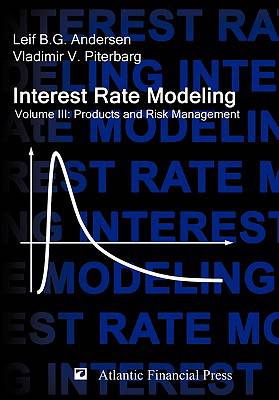
- Afhalen na 1 uur in een winkel met voorraad
- Gratis thuislevering in België vanaf € 30
- Ruim aanbod met 7 miljoen producten
- Afhalen na 1 uur in een winkel met voorraad
- Gratis thuislevering in België vanaf € 30
- Ruim aanbod met 7 miljoen producten
Zoeken
Interest Rate Modeling. Volume 3
Products and Risk Management
Leif B G Andersen, Vladimir V Piterbarg
Hardcover | Engels
€ 184,95
+ 369 punten
Omschrijving
The three volumes of Interest Rate Modeling present a comprehensive and up-to-date treatment of techniques and models used in the pricing and risk management of fixed income securities. Written by two leading practitioners and seasoned industry veterans, this unique series combines finance theory, numerical methods, and approximation techniques to provide the reader with an integrated approach to the process of designing and implementing industrial-strength models for fixed income security valuation and hedging. Aiming to bridge the gap between advanced theoretical models and real-life trading applications, the pragmatic, yet rigorous, approach taken in this book will appeal to students, academics, and professionals working in quantitative finance. The first half of Volume III contains a detailed study of several classes of fixed income securities, ranging from simple vanilla options to highly exotic cancelable and path-dependent derivatives. The analysis is done in product-specific fashion covering, among other subjects, risk characterization, calibration strategies, and valuation methods. In its second half, Volume III studies the general topic of derivative portfolio risk management, with a particular emphasis on the challenging problem of computing smooth price sensitivities to market input perturbations.
Specificaties
Betrokkenen
- Auteur(s):
- Uitgeverij:
Inhoud
- Aantal bladzijden:
- 548
- Taal:
- Engels
Eigenschappen
- Productcode (EAN):
- 9780984422128
- Verschijningsdatum:
- 17/08/2010
- Uitvoering:
- Hardcover
- Formaat:
- Genaaid
- Afmetingen:
- 156 mm x 234 mm
- Gewicht:
- 920 g

Alleen bij Standaard Boekhandel
+ 369 punten op je klantenkaart van Standaard Boekhandel
Beoordelingen
We publiceren alleen reviews die voldoen aan de voorwaarden voor reviews. Bekijk onze voorwaarden voor reviews.








